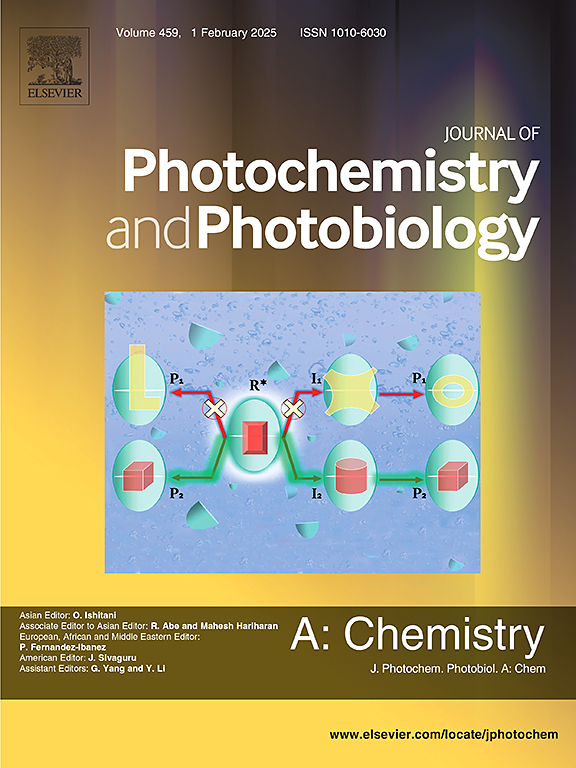Linear relationship between carbonyl index of weathered microplastics with a CC backbone and solar light photodegradation kinetics of nicotine
IF 4.1
3区 化学
Q2 CHEMISTRY, PHYSICAL
Journal of Photochemistry and Photobiology A-chemistry
Pub Date : 2025-07-08
DOI:10.1016/j.jphotochem.2025.116609
引用次数: 0
Abstract
In this study, we argue that the Carbonyl Index (CI) values of weathered microplastics with carbon–carbon backbones can reliably predict their ability to enhance indirect photodegradation of organics under solar light, an effect that is independent of the type of polymer used. Polystyrene (PS), polypropylene (PP), and low-density polyethylene (LDPE) pellets were artificially weathered under UV-C, either in ambient air or submerged in water. Surface changes were characterized using ATR-FTIR spectroscopy, and the CI values were calculated. PS exhibited a much higher weathering rate than PP and LDPE, with air exposure being more effective than water for all plastic types. Nicotine (NIC) was used as the model organic compound. NIC photodegradation (10 mg L−1) was monitored in the presence of each weathered pellet type (50 g L−1) for 6 h under simulated sunlight at pH 11. The apparent pseudo-first-order rate constants, k, were 0.025 ± 0.015 h−1 (air-weathered LDPE), 0.036 ± 0.002 h−1 (water-weathered PP), 0.079 ± 0.029 h−1 (air-weathered PP), 0.216 ± 0.014 h−1 (water-weathered PS), and 0.346 ± 0.016 h−1 (air-weathered PS). A linear correlation (R2 = 0.956) was found between CI and k, indicating that photodegradation is primarily governed by the degree of aging rather than the polymer type. This relationship was further validated using naturally weathered PS and PP items collected from beaches, which aligned with the established CI–k correlation. These findings suggest that the CI is a practical indicator for predicting the environmental reactivity of weathered microplastics.

含CC骨架的风化微塑料羰基指数与烟碱光降解动力学的线性关系
在这项研究中,我们认为具有碳-碳骨架的风化微塑料的羰基指数(CI)值可以可靠地预测它们在阳光下增强有机物间接光降解的能力,这种效果与所使用的聚合物类型无关。聚苯乙烯(PS)、聚丙烯(PP)和低密度聚乙烯(LDPE)球团在紫外线- c下人工风化,要么在环境空气中,要么浸没在水中。利用ATR-FTIR光谱对表面变化进行了表征,并计算了CI值。PS表现出比PP和LDPE高得多的风化速率,在所有塑料类型中,空气暴露比水暴露更有效。以尼古丁(NIC)为模型有机化合物。在pH为11的模拟阳光下,在每种风化颗粒类型(50 g L−1)存在下监测NIC光降解(10 mg L−1)6小时。表观伪一阶速率常数k分别为0.025±0.015 h−1(空气风化LDPE)、0.036±0.002 h−1(水风化PP)、0.079±0.029 h−1(空气风化PP)、0.216±0.014 h−1(水风化PS)和0.346±0.016 h−1(空气风化PS)。CI与k之间呈线性相关(R2 = 0.956),表明光降解主要受老化程度而非聚合物类型的影响。使用从海滩收集的自然风化的PS和PP物品进一步验证了这种关系,这与已建立的CI-k相关性一致。这些发现表明,CI是预测风化微塑料环境反应性的实用指标。
本文章由计算机程序翻译,如有差异,请以英文原文为准。
求助全文
约1分钟内获得全文
求助全文
来源期刊
CiteScore
7.90
自引率
7.00%
发文量
580
审稿时长
48 days
期刊介绍:
JPPA publishes the results of fundamental studies on all aspects of chemical phenomena induced by interactions between light and molecules/matter of all kinds.
All systems capable of being described at the molecular or integrated multimolecular level are appropriate for the journal. This includes all molecular chemical species as well as biomolecular, supramolecular, polymer and other macromolecular systems, as well as solid state photochemistry. In addition, the journal publishes studies of semiconductor and other photoactive organic and inorganic materials, photocatalysis (organic, inorganic, supramolecular and superconductor).
The scope includes condensed and gas phase photochemistry, as well as synchrotron radiation chemistry. A broad range of processes and techniques in photochemistry are covered such as light induced energy, electron and proton transfer; nonlinear photochemical behavior; mechanistic investigation of photochemical reactions and identification of the products of photochemical reactions; quantum yield determinations and measurements of rate constants for primary and secondary photochemical processes; steady-state and time-resolved emission, ultrafast spectroscopic methods, single molecule spectroscopy, time resolved X-ray diffraction, luminescence microscopy, and scattering spectroscopy applied to photochemistry. Papers in emerging and applied areas such as luminescent sensors, electroluminescence, solar energy conversion, atmospheric photochemistry, environmental remediation, and related photocatalytic chemistry are also welcome.

 求助内容:
求助内容: 应助结果提醒方式:
应助结果提醒方式:


